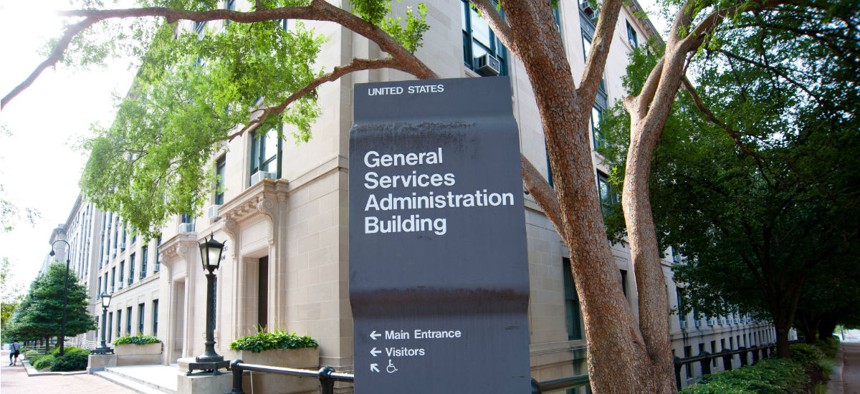GSA Softens Role as Office ‘Space Police’ in Seeking Budget Savings
Buildings Commissioner Norman Dong exploits data analytics to monitor energy use, inventory property.
In December 2011, General Services Administration staff found themselves studying a line graph that tracked energy use at the Captain John F. Williams Coast Guard Building in Boston. The metering data revealed that heating and electricity costs for the non-work day just after Christmas were the same as for a normal work day when the building is populated.
So they notified the mechanical contractor and programed subsequent holidays into the system to save energy and money, an approach since implemented in 81 buildings across GSA through its GSALink tool for achieving smart buildings, according to Public Buildings Service Commissioner Norman Dong.
Conserving energy, lowering leasing costs and reducing the overall federal building footprint are all goals being advanced through data analytics, Dong said at a breakfast forum Thursday sponsored by Johns Hopkins University graduate school and REI Systems.
Every day, building sensors deliver 27 million data points on energy consumption to a central repository, where they are combined on a dashboard and displayed with continually updated budget and schedule information and charted by state from around the country.
With software improvements, the number of contractors needed to process such data dropped from 27 in 2012 to seven in 2015, and will likely go down to four in 2017, Dong said.
Having held top finance positions at the Office of Management and Budget and the Federal Emergency Management Agency, Dong previously was on the receiving end of the Public Buildings Service’s efforts when its National Capital Region officials helped FEMA avoid layoffs by consolidating 11 of its Washington-area facilities and saving $10 million, he recalled.
As “the nation’s largest real estate management organization,” the Public Buildings Service owns or leases some 8,700 assets comprising 378 million square feet. He noted that 480 of those buildings are classified as historic. “There’s a balancing act between helping agencies meet their requirements and fiscal responsibility—our financial stewardship role,” he said.
A Shrinking Footprint
In today’s tightened budget climate—in which GSA is under pressure not merely to freeze the federal footprint but to reduce it—Dong’s team’s efforts to invest in improving and maintaining buildings are confined to the congressionally appropriated portion of the larger Federal Building Fund. “There’s a significant backlog of maintenance and repairs, which underscores how the buildings in the portfolio are aging,” he said.
The agency’s efforts have shrunk the footprint by 21 million square feet since 2012, PBS numbers show, but there is pressure to achieve more. “Excess money spent on rent comes at the expense of mission-critical activities,” Dong said.
Beyond the aggregate level, PBS also deploys analytics on the individual level—herding the vastly different federal agencies toward an office-space per-person “yardstick,” as is done in the private sector, Dong said. PBS arrived at “notional space utilization standard” of 150 square feet per employee. Planners then tabulated percentages of how agencies as different as the Labor and Homeland Security departments diverged from that standard.
“It’s not one size fits all,” Dong stressed, noting that some national security agencies, for example, may need special space to protect secrets. “We let the agencies define what’s important to them and then manage it. GSA used to be known as the `space police,’ but that’s not what’s it’s about,” he added. “We allow some flexibility, and it’s not just about the size of the footprint but the quality of the space.”
During his travels, however, Dong has seen some agencies that give employees 350 square feet—with only 20 percent of the workspaces occupied. “They are ghost towns, with crickets chirping,” he said.
That’s one reason GSA introduced the open-office arrangement at its renovated Washington headquarters at 18 F Street Northwest—with its shared desks and conference rooms for a workforce that often telecommutes. “It has saved $25 million yearly, and is still not fully utilized,” he said.
But not all agency managers are keen on supplying their own square-footage-per-employee numbers. “There’s a lot of pushback. People say they don’t have the information or say, ‘It’s a system problem,’” Dong said. “It’s all about counting people.”
PBS data also shed light on the comparative costs of buildings within the footprint, showing that the least expensive option is to replace a lease, with average savings of 25 percent. Renewing or extending a lease can raise costs by 10 percent, one chart shows.
“We’re trying to “break the mentality of staying for 20 or 40 years, to really capitalize on what we see as the market rate,” he said.
What makes the process work is dialog, Dong said. “We’re looking at opportunities on the horizon, when leases are expiring. Space use has to be aligned with the people in the agency who are writing the checks, where there’s more receptivity to working hand in hand.”
Data analytics helped GSA save $140,000 annually in operations and maintenance contractor costs at a Milwaukee courthouse after a scatter chart of fees showed some outliers “out of whack.”
The agency’s case study on gas consumption for heating and cooling in a Chicago facility showed that at first glance, rises in fuel costs were driven by changes in the weather. “But we dug deeper and challenged that,” Dong said, “and we found equipment and maintenance deficits.”
Dong emphasizes that his specialty is in business processes, not technology. But now he’s fond of asking, “Talk is great, but what are the data?”
(Image via Rena Schild/Shutterstock.com)
NEXT STORY: Courage Is a Muscle. Exercise It.




